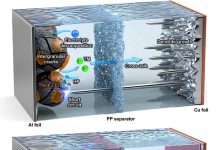
Scientists have found a clever way to make magnesium batteries more stable, which could lead to lighter, cheaper, and longer-lasting energy storage for future devices and electric grids.
In traditional batteries, the anode (one of the two main electrodes) is made beforehand.
But in anode-free batteries, that step is skipped to save space and weight. Instead, during the first charge, the anode forms itself as magnesium (Mg) metal naturally deposits onto a collector surface—usually made of copper or zinc.
This design boosts energy density because there’s no extra anode material taking up room.
However, this approach has a big problem. When magnesium metal starts to grow on the collector, it doesn’t always form smoothly.
Sometimes it grows in sharp, uneven spikes called dendrites. These dendrites can cause the battery to lose capacity, become unstable, or even short-circuit—making the battery unsafe for long-term use.
A research team led by Associate Professor Hee-Dae Lim at Hanyang University in South Korea has now discovered a solution.
Their new method, called a facet-guided metal plating strategy, helps magnesium grow evenly without forming dangerous dendrites.
The work was published in Advanced Energy Materials.
Dr. Lim’s team used zinc (Zn) as a base for magnesium growth because zinc and magnesium have similar atomic structures.
Normally, the surface of zinc metal is uneven, made up of many tiny crystal grains pointing in different directions. These random surfaces make magnesium deposit unevenly.
To fix this, the researchers carefully controlled which part of the zinc crystal was exposed. They treated the zinc surface through a process called thermal annealing to expose its most stable side—known as the (002) facet.
This specific crystal face allows magnesium atoms to spread more smoothly and evenly across the surface.
Then, they polished the zinc surface using a special reactive ion etching technique, creating a clean and uniform layer that further helped magnesium grow flat instead of forming spikes.
When tested in real magnesium batteries, this new zinc base—called P-Zn(002)—showed impressive results. The anode-free magnesium battery kept almost 88% of its original capacity even after more than 900 charge and discharge cycles at high current levels.
This is a huge improvement in both stability and lifespan compared to earlier designs.
Dr. Lim says this new approach could help make next-generation magnesium batteries reliable enough for large-scale energy storage and renewable power systems.
By guiding how metal grows on a microscopic level, researchers are finding ways to build batteries that are not only safer and longer-lasting but also better suited for the clean energy future.
Source: KSR.



